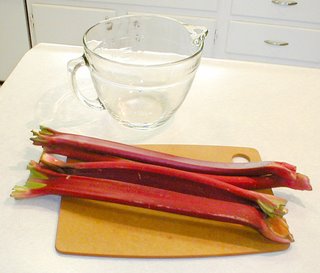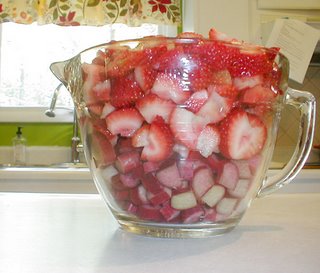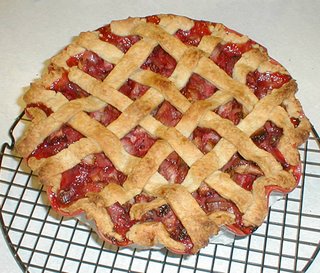THE GRUB REPORT: Ingredient of the Week: Rhubarb
 About a month ago, at the June First Friday festival in downtown Marion, a spring specialty caught my eye at the produce stand. I couldn't pass up the chance to take some of the big, bright red stalks home with me. As I walked back to the office, more than one person among the crowds took notice. As I passed, I heard one or two say, "Oooh, rhubarb!"
About a month ago, at the June First Friday festival in downtown Marion, a spring specialty caught my eye at the produce stand. I couldn't pass up the chance to take some of the big, bright red stalks home with me. As I walked back to the office, more than one person among the crowds took notice. As I passed, I heard one or two say, "Oooh, rhubarb!"Once I got back to work, though, the response wasn’t quite the same. "What," a coworker asked curiously, "is that?!?" She'd never heard of rhubarb. "Preposterous!" I thought. Surely rhubarb, the stuff we found growing in the backyard when my family moved to Yorktown when I was young, wasn't that unpopular. But once challenged to explain what, exactly, it is, I realized that there's nothing quite like it, nothing I could compare it to.
It looks like giant Swiss chard, with texture a little like celery and a taste like, well, like … Like nothing else! The astringent tang. The faintly fruity flavor (even though it is, technically, a vegetable). And the leaves are poisonous, by the way! But this description just doesn't do this wonderfully strange plant justice.

So I did a little poking around online to find out more about it. (I even found a rhubarb festival in a town that calls itself the rhubarb capital of Minnesota!) Turns out this vegetable grows from spring to fall in cooler climates. But it doesn't grow well once temperatures reach 90 degrees, so around here it's pretty much a spring and early summer crop. But it does require cold temperatures to spur it into sprouting, so it doesn't grow well in the South, either.
And, according to http://www.rhubarbinfo.com/, a plant will only grow for so many years before it just dies out. That's what happened to that old plant in my parents' backyard.
All these quirks together have given it the reputation now of being somewhat an old-fashioned exotic, I think.
Well, I say that's a shame. I'm going to lead the charge. I'm going to try my hand at growing rhubarb, and I urge you to too. According to what I found on the Internet, it's a fairly tough plant that can survive neglect. (Something those plants in my parents' backyard, the only plants still there when we moved in, were proof of.) So let's bring back into our regular rotation of treats.
Here's a recipe to help you do that. It features the classic combination of strawberry and rhubarb.

Strawberry Rhubarb Pie
Crust (for one 2-crust pie)
2 2/3 cups all purpose flour
2 tablespoons sugar
1 teaspoon salt
12 tablespoons (1 1/2 sticks) chilled unsalted butter, cut into 1/2-inch pieces
4 tablespoons chilled solid vegetable shortening, cut into ½-inch pieces
6 tablespoons (or more) ice water
Crust (for one 2-crust pie)
2 2/3 cups all purpose flour
2 tablespoons sugar
1 teaspoon salt
12 tablespoons (1 1/2 sticks) chilled unsalted butter, cut into 1/2-inch pieces
4 tablespoons chilled solid vegetable shortening, cut into ½-inch pieces
6 tablespoons (or more) ice water
Filling
1/2 cup sugar
1/2 cup golden brown sugar
1/4 cup cornstarch
1 teaspoon grated lemon rind
1/8 teaspoon ground nutmeg
Pinch of salt
2 1/2 to 3 1/2 cups sliced fresh strawberries (about 16 oz.)
2 1/2 to 3 1/2 cups fresh (1/4-inch-thick) rhubarb slices (1 1/2 pounds or more)
2 tablespoons fresh lemon juice (or less if you want your pie on the sweet end of the sweet-tart flavor combo)
1-2 tablespoons butter or margarine, cut into pieces
1/2 cup sugar
1/2 cup golden brown sugar
1/4 cup cornstarch
1 teaspoon grated lemon rind
1/8 teaspoon ground nutmeg
Pinch of salt
2 1/2 to 3 1/2 cups sliced fresh strawberries (about 16 oz.)
2 1/2 to 3 1/2 cups fresh (1/4-inch-thick) rhubarb slices (1 1/2 pounds or more)
2 tablespoons fresh lemon juice (or less if you want your pie on the sweet end of the sweet-tart flavor combo)
1-2 tablespoons butter or margarine, cut into pieces
Make crust:
Mix flour, sugar and salt for crust in food processor or stir well.
Mix flour, sugar and salt for crust in food processor or stir well.
Add butter and shortening. Using on/off turns with processor, or by hand with pastry blender, mix until mixture resembles coarse meal.
Drizzle 6 tablespoons ice water over mixture. Process or mix just until moist clumps form, adding more ice water by teaspoonfuls if dough is dry.
Gather dough into ball; divide and flatten each half into a disk. Wrap in plastic; chill until dough is firm enough to roll out, about 30 minutes.
Roll out half of dough on lightly floured work surface to 12-inch round (about 1/8 inch thick).
Transfer dough to 9-inch-diameter pie dish. Trim excess dough, leaving ¾-inch overhang. Chill, covered, until ready to use, up to 2 days.
Prepare filling:
Preheat oven to 400 degrees.
Combine first 5 ingredients; stir in strawberries, rhubarb, lemon juice and pinch of salt. Let stand 20 minutes.
Compose pie:
Meanwhile, roll out second half of dough to about a 13-inch round, about 1/8-inch thickness, and cut into 1/2-inch strips for lattice top.
Spoon mixture into crust and dot with 1 to 2 tablespoons of butter.
Arrange strips in lattice pattern on top of pie (five to seven strips one way, five to seven the other, basketweave pattern if desired), trim ends if needed, then fold under edges and crimp decoratively.
If desired, brush crust with egg/water wash or with water and sprinkle with coarse sugar.
Bake:
Bake:
Place pie plate on baking sheet (lined with foil if desired) to catch drips.
Bake at 400 degrees for 20 minutes, reduce heat to 350 degrees and bake until pie is golden and filling thickens about 1 hour and 25 minutes.
Transfer pie to cooling rack and cool completely.
Originally posted to The Grub Report by Patricia Gibson on Wednesday, October 29, 2008 6:45 PM EDT
Labels: food, grubreport, recipes
posted by Tricia at
3:42 AM
![]()
![]()


0 Comments:
Post a Comment
Subscribe to Post Comments [Atom]
<< Home